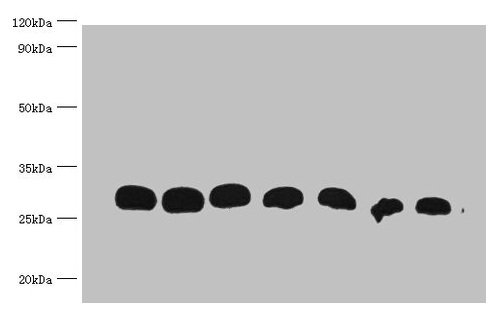
All lanes : Recombinant GST Protein at 30ng/ml Line 1:Mouse Anti-GST monoclonal antibody at 1:1000 Line2:Mouse Anti-GST monoclonal antibody at 1:2000 Line3:Mouse Anti-GST monoclonal antibody at 1:5000 Line4:Mouse Anti-GST monoclonal antibody at 1:10000 Line5:Mouse Anti-GST monoclonal antibody at 1:20000 Line6:Mouse Anti-GST monoclonal antibody at 1:40000 Line7:Mouse Anti-GST monoclonal antibody at 1:80000 Predicted band size : 28kd Observed band size : 30kd
GST Monoclonal Antibody
CSB-MA000031M0M
ApplicationsWestern Blot, ELISA
Product group Antibodies
ReactivityAll Species
Overview
- SupplierCusabio
- Product NameGST Monoclonal Antibody
- Delivery Days Customer20
- ApplicationsWestern Blot, ELISA
- CertificationResearch Use Only
- ClonalityMonoclonal
- Clone ID2A81D2
- ConjugateUnconjugated
- HostMouse
- IsotypeIgG2a
- Scientific DescriptionGenetic engineers have used glutathione S-transferase to create the GST gene fusion system. This system is used to purify and detect proteins of interest. In a GST gene fusion system, the GST sequence is incorporated into an expression vector alongside the gene sequence encoding the protein of interest. Induction of protein expression from the vectors promoter results in expression of a fusion protein: the protein of interest fused to the GST protein. This GST-fusion protein can then be purified from cells via its high affinity for glutathione. GST is commonly used to create fusion proteins. The tag has the size of 220 amino acids (roughly 26 KDa), which, compared to other tags like the myc- or the FLAG-tag, is quite big. However, many commercially-available sources of GST-tagged plasmids include a thrombin domain for cleavage of the GST tag during protein purification.
- ReactivityAll Species
- Storage Instruction-20°C or -80°C
- UNSPSC12352203
